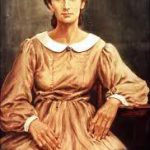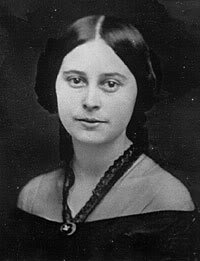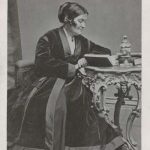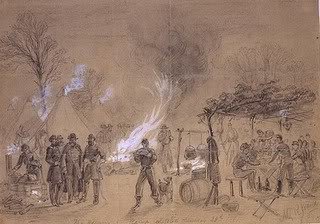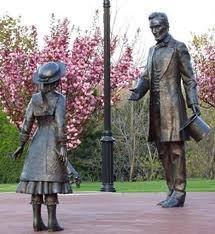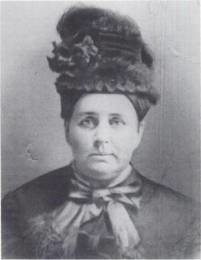Stepmother of Abraham Lincoln
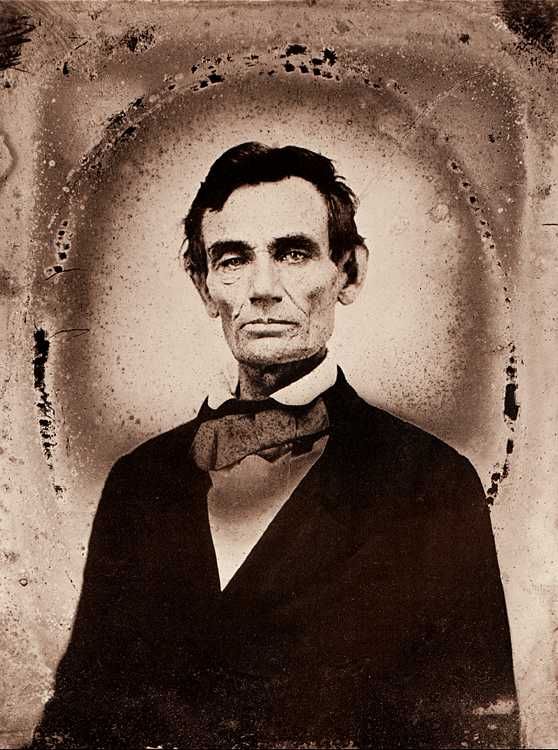 Sarah Bush Lincoln (December 13, 1788 – April 12, 1869) was the second wife of Thomas Lincoln and stepmother of Abraham Lincoln. While Lincoln’s relationship with his father appeared to be strained, he remained close to his stepmother after he left home to make his way in the world. After becoming a successful attorney in Springfield, Illinois, Abraham Lincoln saved his family’s land from forced sale.
Sarah Bush Lincoln (December 13, 1788 – April 12, 1869) was the second wife of Thomas Lincoln and stepmother of Abraham Lincoln. While Lincoln’s relationship with his father appeared to be strained, he remained close to his stepmother after he left home to make his way in the world. After becoming a successful attorney in Springfield, Illinois, Abraham Lincoln saved his family’s land from forced sale.
Early Years
Sarah Bush was born in Hardin County, Kentucky, on December 13, 1788. She was one of three daughters of Christopher and Hannah Bush. The Bush family consisted of nine children. The male children were William, Samuel, Isaac, Elijah, Christopher and John. The female children were Hannah, Rachel and Sarah. By the time Sarah was two years old, the family had moved to Elizabethtown, Kentucky, where Sarah grew up.
Sarah knew Thomas and Nancy Hanks Lincoln while they lived in Elizabethtown. Thomas was active in community and church affairs in Hardin County, but he lost farms three times because of boundary disputes, possibly land fraud. Discouraged by these setbacks, he decided to move his family to Indiana. Abraham Lincoln noted years later that the move was “partly on account of slavery, but chiefly on account of the difficulty of land titles in Kentucky.”
Sarah Bush married Daniel Johnston on March 13, 1806, and they had three children. Little is known about Daniel Johnston except that he was always in debt. In 1814, Johnston was appointed jailer of Hardin County. Living quarters for the jailer and his family were provided in one corner of the stone jail. Sarah cooked for the inmates, kept the jail clean and cared for her three young children: Elizabeth, Matilda and John.
In the summer of 1816 Daniel Johnston died. Sarah then moved into a cabin owned by Samuel Haycraft. She later purchased the cabin and lived there with her three children.
In December 1816, the Lincolns settled near Little Pigeon Creek where Thomas and Abraham set to work carving a home from the Indiana wilderness. Father and son worked side by side to clear the land, plant the crops and build a home. Thomas also worked as a carpenter as the community grew.
In October 1818, Nancy Hanks Lincoln contracted milk sickness by drinking milk from a cow that had eaten the white snakeroot plant. There was no cure for the disease and on October 5, 1818, Nancy died at the Lincoln farm in southern Indiana. For over a year, Thomas and his children lived alone.
Stepmother of the President
In late 1819 Thomas Lincoln returned to Kentucky and proposed marriage to widow Sarah Bush Johnston. She accepted on condition that her late husband’s debts be paid. On December 2, 1819 they were married, the second marriage for both Thomas (age 41) and Sarah (age 31). Together they traveled to the Pigeon Creek settlement in Indiana with all of her worldly possessions.
Sarah Bush Lincoln and her three children – Elizabeth (13), Matilda (10) and John (9) – joined Abraham (10), his sister Sarah (12) and Dennis Hanks (20) (a cousin of Nancy Hanks Lincoln) to make a new family of eight. (Abraham’s sister Sarah later died at age 20 while giving birth to a stillborn son.)
Sarah provided a refreshing new home life for both Lincoln children, treating them like her own children. Abraham said of his stepmother “she proved to be a good and kind mother.” Sarah soon discovered that her new stepson was very intelligent and had a passion for knowledge; he was especially fond of reading. Although she was illiterate, Sarah’s possessions included several books: Aesop’s Fables, Robinson Crusoe, Bunyan’s Pilgrim’s Progress and Sinbad the Sailor, which she gave to Abraham.
Her gift left an indelible impression on Abraham. Not only were books priceless treasures to a boy who loved to read on a frontier where books were scarce, but it was an indication to him that Sarah would pick up where his mother had left off in terms of encouraging his quest for knowledge. The two quickly developed a close relationship that would continue for the rest of Abraham’s life.
Saran remembered, “His mind and mine, what little I had, seemed to run together, more in the same channel.” She added other information, vital to future biographers – that he cared little for clothes or food, but a great deal for ideas. Also, tucked away in her memories, the surprising physical fact that young Lincoln was “more fleshy in Indiana than ever in Illinois.”
Under her guidance, Abraham made rapid progress. “He read all the books he could get his hands on,” Sarah recalled, and was already practicing writing and speaking at a young age. After hearing sermons by a local preacher, he would sometimes stand on a stump and “almost repeat it word for word.” Mrs. Lincoln considered her stepson a model child who was always honest, witty and “diligent for knowledge.”
Sarah told William Herndon (Abraham Lincoln’s law partner) that “Abe was the best boy I ever saw” and that he “never gave me a cross word or look.” Thomas Lincoln viewed his son’s studious ways as a waste of time. Sarah tried to persuade her husband to look more kindly on Abraham’s reading habits, but the distance between father and son only widened.
In the 1820s, Thomas was under considerable financial pressure (because of aging and ill health) to support his family of eight. For a time he could rely on Dennis Hanks to help provide for his large family, but in 1826 Dennis married Elizabeth Johnston, Sarah Bush Lincoln’s daughter, and moved to his own homestead.
As Abraham became an adolescent, his father grew more and more to depend on him for the “farming, grubbing, hoeing, making fences” necessary to keep the family afloat. He also regularly hired his son out to work for other farmers in the vicinity, and by law he was entitled to everything the boy earned until he came of age. At age eighteen (1827), Lincoln was 6 feet 4 inches tall, so tall that his head nearly touched the ceiling of the family’s kitchen.
By 1827 Thomas Lincoln owned 100 acres of land, and in 1829 he began building a better cabin. However, when cousin John Hanks moved to Illinois and sent back glowing reports of fertile prairie that did not need the backbreaking work of clearing forest before crops could be planted, Thomas sold his Indiana property early in 1830 and moved the family to Macon County, Illinois.
After a wretched winter in 1830-1831 marooned by snow in a crude cabin west of Decatur, young Abraham, age 22, left the family to start his own homestead and seek his fortune in Sangamon County – first at New Salem (until 1837) and then at Springfield.
Thomas Lincoln started back to Indiana in the spring of 1831. En route, he stopped in Coles County to visit relatives who persuaded him to settle there and give Illinois another chance. The Lincolns lived on three different farms in Coles County. In 1840 Thomas purchased the last farm – a small plot near the Embarras River, part of what was then called Goosenest Prairie.
The Goosenest Prairie farm was about ten miles south of Charleston, Illinois, on the southern edge of Coles County. The Lincolns lived there in a saddlebag cabin: a cabin of two rooms with a central chimney and additional sleeping and storage space in a loft or attic accessed by a ladder. The two rooms had separate entrances and there was no interior door between them.
Life at Goosenest Prairie was probably typical of most subsistence farm families in central Illinois in the 1840s. Using a combination of age-old hand tools and daily drudgery, they raised corn, oats and wheat. Livestock included hogs, sheep, milk cows, horses, chickens and geese. Pork, potatoes, and cornbread – staples of the rural diet – were supplemented with wild game, orchard produce and garden vegetables.
Thomas Lincoln, already in his fifties, remained a resident of Coles County for the rest of his life. By 1841 he owned 120 acres of land. By 1845 as many as 18 people were living in the saddlebag cabin, including Sarah’s son John D. Johnston, his wife Mary and their six children; Sarah’s daughter Matilda, her husband Squire Hall and their six children. This extended-family arrangement was common in Appalachian Southern culture.
Sometime later, Abraham Lincoln, now a rising state legislator, bought a third of the Lincoln land to get his father out of financial difficulty. In 1848 Abraham also gave his father $20 to save the rest of the land from forced sale. However, he did not visit his parents as often as he could have. As a lawyer, he visited Charleston, Illinois – site of the Coles County courthouse – quite frequently, and no doubt had contact with all the nieces and nephews of the Hanks family who lived there. However, his parents saw him “every year or two.”
Although Abraham rushed to see his father during an illness in 1849, he did not see him on his deathbed in January 1851, citing his work and the recent birth of his son Willie the month before as his reasons. This has led scholars to speculate about what may have been a difficult relationship. Abraham Lincoln wrote to his stepbrother John D. Johnston (to whom Thomas Lincoln was much closer):
Say to him that if we could meet now, it is doubtful whether it would not be more painful than pleasant; but that if it be his lot to go now, he will soon have a joyous meeting with many loved ones gone before; and where the rest of us, through the help of God, hope ere-long to join them.
Thomas Lincoln died at the Goosenest Prairie farm in 1851 at age 73, and was buried about a mile west of the farm at the Shiloh Cemetery. Sarah Bush Lincoln’s grandson John J. Hall came into possession of the farm upon Thomas’ death, and lived there until the cabin was dismantled and sent to the Columbian Exposition in Chicago in 1893.
Late Years
Sarah’s three children were all married, and by the 1850s she was a grandmother to over 20 children. She lived at various times with her son, two daughters and grandchildren. She remained an energetic person, but occasionally suffered from rheumatism. Abraham Lincoln retained a 40-acre plot of land in his own name “for Mother while she lives,” and otherwise tended to her welfare as best he could from a distance.
After Abraham Lincoln was elected president in 1860, he traveled to Coles County to bid farewell to his family before going to Washington for his inauguration. He visited Sarah Bush Lincoln, age 72, on January 31, 1861, at the home of her daughter, Matilda Moore, a mile north of Goosenest Prairie in the former village of Farmington. Lincoln visited the house as residents turned out for a big dinner in his honor.
During this visit Abraham and Sarah rode out to Shiloh Cemetery to visit the grave of Thomas Lincoln before catching a train for Springfield. There are several versions of their final goodbye. It seems that Sarah had a premonition that this would be the last time they would ever meet.
A letter written by one of Sarah’s relatives recorded the scene:
She embraced him when they parted and said she would never be permitted to see him again, that she felt his enemies would assassinate him. He replied, “No, no, Mama (he always called her Mama) they will not do that. Trust in the Lord and all will be well. We will see each other again.”
Four years later, another lawyer from Springfield, who was in mourning like the rest of the country, made the pilgrimage to Coles County after President Lincoln’s assassination. William Herndon, Lincoln’s former law partner, traveled there to interview those who had known Lincoln, and to record their impressions of him.
Nearly every story we know of the young Abraham Lincoln is traceable to Herndon’s research in Coles County in 1865. Herndon found Sarah Bush Lincoln feeble and breathing with difficulty, but she was able to answer simple questions about her life. When Sarah was told of her stepson’s death, she wept.
Sarah Bush Lincoln died April 12, 1869 at age 80, and was buried with her second husband Thomas Lincoln, in Shiloh Cemetery, just south of Lerna, Illinois.
Lincoln Log Cabin State Historic Site preserves the site of the 1840s farm of Thomas and Sarah Bush Lincoln, father and stepmother of our 16th president. It is an 86-acre history park that is located eight miles south of Charleston, Illinois. Its centerpiece is an accurate reproduction of the Lincolns’ two-room log cabin, surrounded by the cornfields, gardens, orchards, livestock and outbuildings that would be found on a farm of the period.
SOURCES
Abraham Lincoln’s Parents
Wikipedia: Thomas Lincoln
Wikipedia: Sarah Bush Lincoln
Wikipedia: Lincoln Log Cabin State Historic Site
